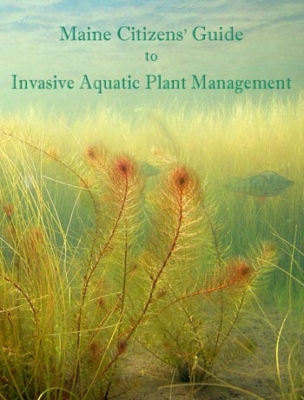 After five years of research and action, the Maine Milfoil Initiative—a collaboration between Saint Joseph’s College and several Maine lakes associations and volunteer groups—has culminated their work with the publication of the Maine Citizens’ Guide to Invasive Aquatic Plant Management. This is a nuts-and-bolts guide for lake groups and citizens on how to develop a management program to stop the proliferation of non-native variable-leaf milfoil and other invasive aquatic plants.
After five years of research and action, the Maine Milfoil Initiative—a collaboration between Saint Joseph’s College and several Maine lakes associations and volunteer groups—has culminated their work with the publication of the Maine Citizens’ Guide to Invasive Aquatic Plant Management. This is a nuts-and-bolts guide for lake groups and citizens on how to develop a management program to stop the proliferation of non-native variable-leaf milfoil and other invasive aquatic plants.
Since 2009, the Maine Milfoil Initiative has fought to help prevent the spread of non-native variable-leaf milfoil, manage its eradication, and study its effects on the ecology of Maine lakes. The joint effort began with Saint Joseph’s College, the Lakes Environmental Association (Bridgton), Maine Congress of Lakes Associations (Belgrade), the Maine Volunteer Lake Monitoring Program, and nine lake associations. Their goal: to stop the proliferation of the non-native plant that has resulted in dense growths in several of southern Maine’s lakes, including Sebago Lake where the College is located.
With the help of the College and Senator Susan Collins, the Initiative received a $500,000 federal grant from the U.S. Fish and Wildlife Service in 2009 to fund its program efforts. According to aquatic plant biologist and Maine Milfoil Initiative Project Director Jacolyn Bailey, the funding was used to bring together seven lake groups as test lakes, study the areas, and help bring their management efforts to the next level.
The Initiative has since continued to gain momentum. Co-authored by Bailey and Roberta Hill, aquatic ecologist and invasive species program director for the Maine Volunteer Lake Monitoring Program, the free guide is for anyone affected by or interested in managing, eradicating, and otherwise informing themselves and the public about invasive aquatic plant life.
“We took all the information we recorded from the Lake Groups and tried to make a comprehensive guide, both for people dealing with infestations and for those worried about possible infestations,” says Bailey. “We have shown them step by step how to pull together a management group.”
The guide provides information necessary to write and implement an action plan that effectively manages invasive plant infestations, including costs associated with starting a program and later management. Also included are numerous case studies of how invasive aquatic plants are being removed and managed in a range of water body types, taking into account the varying resources available to lake groups.
“We touch on everything from how to form a lake association and the importance of having a management system, to the nitty-gritty of control work,” Bailey adds.
The Maine Citizens’ Guide to Invasive Aquatic Plant Management puts the power to make a change in the hands of anyone, not only for Maine, but for other states, as well.
“Our hope is that this is a great resource for Maine lakes,” says Bailey, “but it is also applicable for any other state dealing with an invasive aquatic plant. We are hopeful that other states would be interested in using it as well.”


